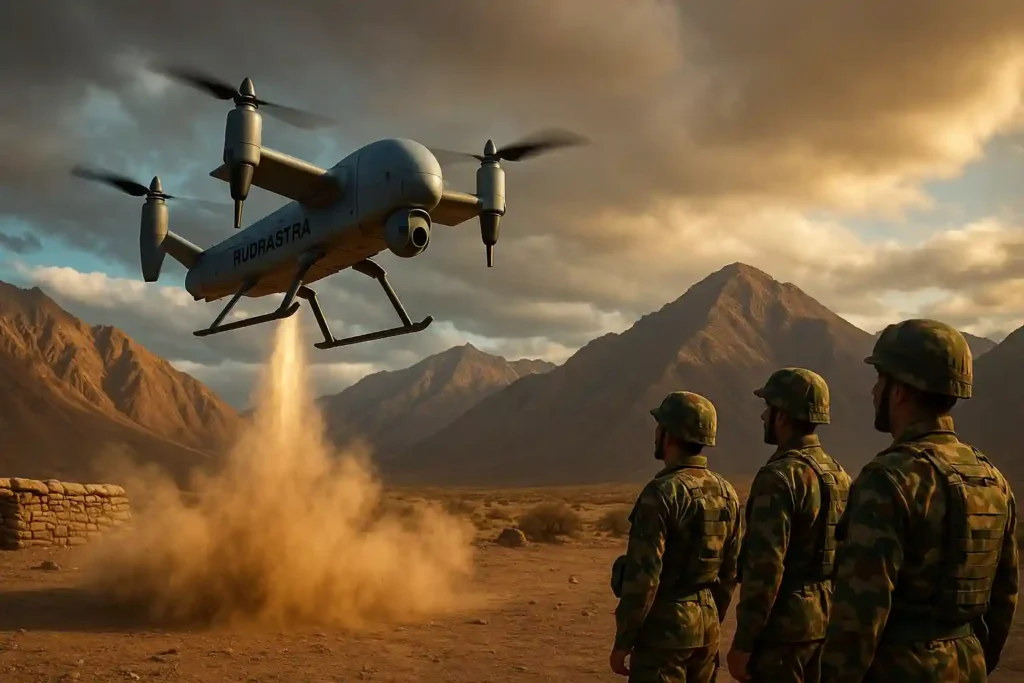As modern warfare shifts from brute strength to intelligent precision, India is rewriting its military playbook. At the forefront of this transformation is the emergence of long-range loitering munitions—AI-powered drones that hover, hunt, and strike with deadly accuracy.
These advanced unmanned aerial systems don’t just observe—they engage. Combining surveillance, autonomous targeting, and pinpoint strike capability, they allow India to neutralise threats deep across borders while keeping pilots out of harm’s way. With a focus on AI navigation, encrypted communication, and terrain versatility, these drones are fast becoming a central pillar of India’s evolving defence strategy.
In the following sections, we’ll break down India’s operational experience with loitering munitions, explore its indigenous platforms like Rudrastra and Nagastra, and explain why these drones are vital for tomorrow’s wars.
Operation Sindoor: A Milestone in India’s Drone Warfare
In May 2025, India made history with Operation Sindoor, marking its first successful deep-strike mission using long-range loitering munitions. This bold operation exemplified a transformative leap in India’s offensive drone capabilities.

For the first time, Indian loitering drones crossed into Pakistani airspace and hit high-value targets without risking manned aircraft. Among the key assets neutralised were:
- Chinese-supplied HQ-9 and HQ-16 air defence missile systems
- Multiple Pakistan Air Force radar stations
Drones such as the Israeli-origin Harop, operated by India, demonstrated the ability to conduct Suppression of Enemy Air Defence (SEAD) missions independently. With up to nine hours of endurance, they hunted targets, waited patiently in loiter mode, and struck with surgical precision once enemy systems were exposed.
This landmark strike not only highlighted India’s growing mastery in autonomous drone operations but also proved that long-range loitering munitions could redefine how the Indian military neutralises air defence threats deep inside hostile territory.
Government Response: Rapid Expansion and Procurement
Following this breakthrough, the Ministry of Defence (MoD) authorised an accelerated replenishment of advanced strike systems, including:
- Long-range loitering munitions
- Kamikaze drones for surgical attacks
- BVR air-to-air missiles
- Precision-guided artillery shells
According to reports from Hindustan Times and India Today, this decision was driven by the need to outmatch China-supplied systems deployed by Pakistan and to modernise India’s battlefield capabilities.
Homegrown Innovation: Rudrastra UAV and the Nagastra Series
India’s approach to drone warfare isn’t just about imports—it’s about building world-class systems at home.

Rudrastra UAV: A Hybrid Strike Solution
Developed by Solar Defence and Aerospace Limited (SDAL) in Nagpur, the Rudrastra UAV is India’s first indigenously developed VTOL-capable loitering munition. Key specs include:
- 170+ km operational range
- 90-minute loitering endurance
- 8 kg precision warhead with GPS guidance
- Autonomous flight and obstacle avoidance
- Encrypted EO/IR sensor feed for real-time targeting
After successful live-fire trials at Pokhran in June 2025, Rudrastra is being inducted into frontline border units.
Nagastra-1 and Nagastra-3: Tactical and Strategic Edge
Developed by Solar Industries India, the Nagastra series highlights India’s growing strength in indigenous drone manufacturing:

- Nagastra-1 offers a range of 30–40 kilometres and carries a 9 kg warhead. Over 600 units have been delivered to Indian forces since 2024, supporting tactical missions across difficult terrain.
- Nagastra-3, currently undergoing advanced trials, features a range of over 100 kilometres and is designed for extended missions with enhanced endurance. It provides strategic strike capabilities deep behind enemy lines.
This tiered approach provides Indian forces with both close-range and deep-strike flexibility, depending on the mission profiles and terrain.
Why These Drones Matter: Strategic Implications
The value of long-range loitering munitions extends far beyond a single battle. These drones:
- Eliminate the need for runways with VTOL launch
- Hover for hours, ready to strike when the target appears
- Offer SEAD capability against mobile or hidden air defences
- Enable GPS-denied autonomous strike operations
- Reduce costs and risk compared to manned air missions
As Air Marshal Ashutosh Dixit wisely noted, these technologies make geographical barriers irrelevant, inspiring us to connect and transcend boundaries.
The Nagpur Advantage: India’s Emerging Drone Hub
Nagpur has risen to become the heart of India’s inspiring journey in drone manufacturing. Housing major players like SDAL, BrahMos Aerospace, and JSR Dynamics, the city now produces:

- Long-range kamikaze drones
- VTOL-enabled strike UAVs
- Counter-swarm systems like Bhargavastra
In June 2025, Prime Minister Narendra Modi inaugurated India’s first private drone testing runway in the city, signalling high-level support for indigenous drone expansion.
A New Kind of Arms Race: India vs Pakistan
Pakistan’s use of Turkish Songar drones in recent cross-border skirmishes has prompted India to scale up its drone arsenal aggressively. According to Reuters:

- India’s UAV budget surged to $470 million
- Strategic focus has shifted to long-range, AI-enabled drones
- Integration with the Army and IAF command networks is ongoing
This reflects a broader shift—from manned engagements to unmanned, algorithm-driven warfare that prioritises speed, accuracy, and persistence.
Final Thoughts: Future-Proofing Indian Warfare
From the battlefield lessons of Operation Sindoor to the upcoming deployment of Nagastra-3, India’s investment in long-range loitering munitions signals a profound change in its warfighting doctrine. These drones don’t just complement conventional weapons—they extend India’s strategic reach, enhance deterrence, and reduce operational risk.
As regional threats evolve, India’s unmanned systems are not just keeping pace—they’re setting the standard.
